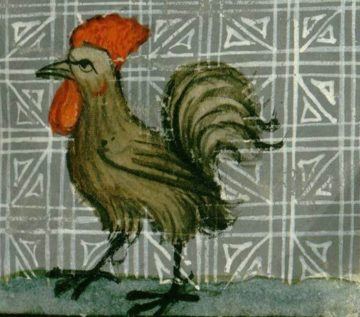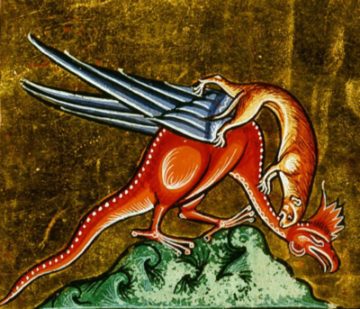by Eric Bies

Birds talk in Chaucer. Three of his twenty-four Tales of Caunterbury practically center on speaking beaks, and a long poem preceding these, the Parlement of Foules, may have been written with no better motive than the trial and joy of Englishing chirps and squawks. We are told up front in “The Nun’s Priest’s Tale” that “beestes and briddes koude speke and synge,” a rather no-nonsense preamble to permitting Chauntecleer and Pertelote (a rooster and a hen) their colloquy on dream hermeneutics in a Jungian tongue, and though the word “auspice” hadn’t yet been coined in Chaucer’s day, the Latin from which it springs—auspex, literally “birdwatcher”—would have been familiar enough. Still, one never finds Chaucer’s birds articulating an oracular shape: there is nothing in them, really, to watch for. They resemble instead the simple, good-natured birds of Assisi, who helped form the first eager audience for an Umbrian friar’s itinerant preaching—birds of the same sort Henry David Thoreau mentions in the fifteenth chapter of Walden:
I once had a sparrow alight upon my shoulder for a moment while I was hoeing in a village garden, and I felt that I was more distinguished by that circumstance than I should have been by any epaulet I could have worn.
Although there is no evidence that the bird could communicate any further than the touch of its twiggy toes upon the writer’s shoulder, such a touch was enough. Had the sparrow tipped out from the end of Chaucer’s quill, however, it may have ventured to ask how the writing was going. For hadn’t Mr. Thoreau gotten it into his head, seated in his cabin at Walden Pond, to put pencil to paper and compose a book?
Indeed he had, and in that very book—his first, A Week on the Concord and Merrimack Rivers—Thoreau’s imagination is a wonder. Look:
In all her products Nature only develops her simplest germs. One would say that it was no great stretch of invention to create birds. The hawk, which now takes his flight over the top of the wood, was at first, perchance, only a leaf which fluttered in its aisles. From rustling leaves she came in the course of ages to the loftier flight and clear carol of the bird.
Yet, if a bird could arise from a leaf, why not a “hail fellow well met” to follow from its throat? We seem to have decided, as a species, that we shall not tolerate birds that talk—unless, like the flamboyantly feathered parrots that Columbus made off with as bounty from his Taino hosts, their talking amounts to little more than mimicry. Even Jacques de Vaucanson, who instructed his mechanical duck to defecate in polite company, prohibited it from idle chatter. Of course, there is also the occasion for, well, a fear of our feathery friends, as witness that one horrific Hitchcock flick, or, before it, Nikolai Gogol and Edgar Allan Poe gathering terror around the specific concept of a talking bird; and when the world was sated blue with deluge, it was a raven that Noah sent forth from his ark—notably prior to humanity’s beloved dove, and never to return—perhaps because the raven was mouthing threats of mutiny.

Painter Carl Wilhelm de Hamilton’s The Parliament of Birds, a nineteenth-century illustration of the Chaucer poem, teems, not quite terribly, but teems with wings and feathers to form a living tableau as dense as any picture by Hieronymus Bosch. But Stanley Spencer’s claustrophobic St Francis and the Birds frankly does terrify, lending an absurd plausibility to the image of Francis upon the craggy heights of La Verna, preparatory to thunderous stigmata, when the branches of beeches and elms were heard to splinter beneath so much avian attendance.
With Chaucer, though, birds received a place of special honor. Think of the crow in “The Manciple’s Tale,” who tattles on Phoebus’s wife for sleeping around and earns the same kind of Ovidian punishment any disappointing person might. (Actually, it isn’t hard to argue that the crow gets off easier than his human counterparts—merely changing color, white to black, and not into something else, like a spider or a tree!) In “The Squire’s Tale,” it is a magic ring that grants its wearer the ability to locate coherence in the desperate cries of a heartbroken falcon, who grieves her lost love:
He saugh upon a tyme a kyte flee
And sodeynly he loved this kyte so
That al his love is clene fro me ago;
And hath his trouthe falsed in this wyse.
More than a minor annoyance, then, that we never do find out if the falcon and her selfish tiercel get back together. After all, the twenty-four tales that Chaucer had completed by the time of his death in 1400 AD fail to account for even a quarter of the total projected: of those twenty-four, “The Squire’s Tale” holds the unique distinction of being a tale told in parts—ending on one of the first cliffhangers in world literature—so that the Squire leaves us wondering what happens next, not only to the falcon and her Orphically ringed savior—one Canacee, daughter of an Eastern kingdom that may have been modeled on the golden horde of Chinggis Khan—but to the other magical objects (a bronze horse that can fly!) that enter into the narrative.
But then, birds have been vanishing into the folds of history since time immemorial. Gilbert White, the first modern naturalist, couldn’t conclude whether the swallows that disappeared from Selborne every autumn made migrations or merely hid away for the winter, like the toads in their Albion burrows; and if the Greek tradition had had any say in it, then the Great Sphinx of Giza may once have spread wings from its stately back (and been in fact a kind of Griffin). The awkward, lumbering dodo disappeared into extinction, beneath the cartoon bloom of Stone Age muskets, exactly 360 years ago, and the more we learn of the Jurassic, the better we understand just how feathery dinos really were. Jorge Luis Borges, in his Book of Imaginary Beings, anticipated this discovery (and should have been consulted by Steven Spielberg) in an entry on “The Basilisk”:
Pliny the Elder (VIII, 33) tells us that the Basilisk was a serpent “with a white spot on its head, strongly resembling a sort of a diadem.” From the Middle Ages onward, however, it was a crowned, quadrupedal cock with yellow plumage and great thorny wings; only its tail was that of a serpent.

Something analogous to the legendary triumph of mice over elephants (and mongooses over cobras, for that matter) describes the strange medieval belief that the mighty basilisk was best put to rout by the common weasel. This may explain Chaucer’s decision, in “The Parson’s Tale,” to make mention of the creature—a “basilicok,” though only in passing—just so that he might preserve, like a leaf pressed flat, one more bryd in his bok.
